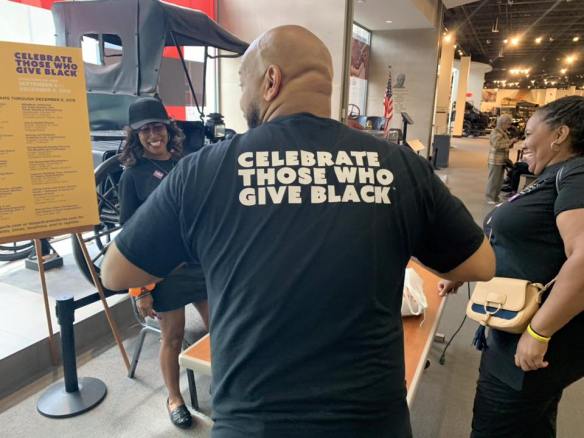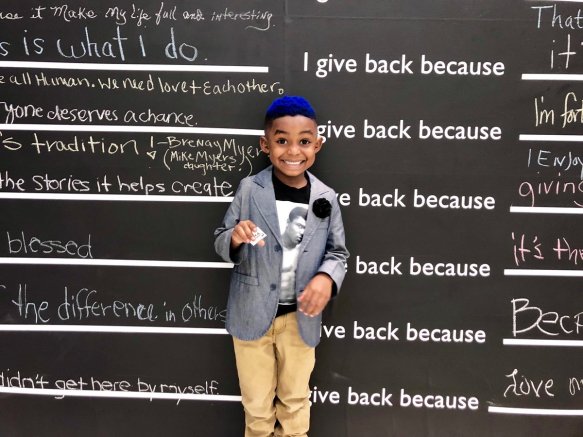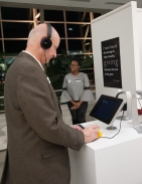
From an exhibition of The Soul of Philanthropy, a text vinyl on gallery window that overlooks a neighborhood streetscape. Photo credit: Valaida Fullwood
Reframing portraits of philanthropy. Surprising to many, seemingly heretical to some, this idea fuels my imagination and writing. Over a decade ago, I began exploring multiple facets of philanthropy, particularly traditions of giving among African Americans. Struck by what seemed a whitewashing of mainstream philanthropy, which too often centers on financial wealth and whiteness, I was compelled to write about and lift up the unsung generosity of people of color as well as folks of modest means and all socioeconomic levels. This requires a modern reclamation of philanthropy—in meaning, in imagery and in practice.
Examining the root meaning of a word unlocks understanding. Greek in origin, philanthropy translates as “love of humanity.” Over centuries, the word has evolved in connotation and, today, is applied to activity ranging from individual and family practices to institutional grant-making to corporate social responsibility to global impact investing. Philanthropy, when interpreted broadly, can encompass a wide scope of beliefs and take many forms. Even so, most Americans point to only a sliver of this activity, largely because the quantity of dollars has come to eclipse the love of humanity as a defining feature of philanthropy.
The decades around the turn of the 20th century saw the rise of industrial magnates such as Andrew Carnegie, Henry Ford and John D. Rockefeller, whose exploits and enterprises amassed great fortunes. Their extraordinary financial donations to myriad causes and institutions contributed to the whittling down of ideas about philanthropy. Today, for many, philanthropy is synonymous with immense financial wealth. While but one facet, philanthropy centered on an abundance of money distorts the full picture.
Writer Chimamanda Ngozi Adichie has a much-viewed TED Talk about “the danger of a single story” and the destructive nature of stereotypes when only one story is told and re-told. Troubling to me is philanthropy’s single story, patterned from wealthy white men of a bygone era. It is the story that has dominated the field for over a century and one that too often places Black people solely on the demand side of communal assistance—as only beneficiaries and “those in need.”
And that’s the thing about philanthropy. A far richer picture exists. In fact, studies reveal a striking irony. Black Americans give the highest percentage of discretionary income to philanthropic causes when compared to other racial groups, as reported by W.K. Kellogg Foundation and research of the Urban Institute. Stunningly, Blacks not only fail to receive due recognition, we also are frequently cut from conventional depictions of philanthropists. To add insult to injury, the script is flipped and dishonestly says, “Blacks don’t give” and “they’re looking for handouts.”
This knowledge gave birth to the Giving Back Project, which aims to tell a broader range of American philanthropy stories to restore “love” as the defining force in philanthropy. Expounding on an MLK quote, Bishop Michael Curry said in this now-famous royal wedding sermon: There’s power in love. Don’t underestimate it. Don’t even over-sentimentalize it. There’s power, power in love.
Sharing this belief, I choose to frame philanthropy around the human factor and the powerful force of love, instead of money alone. In deconstructing the Greek translation, my re-interpretation is “love of what it means to be human.” Broad and inclusive, this frame applies to the writing and photography of the Giving Back Project, which includes my book Giving Back: A Tribute to Generations of African American Philanthropists and the multimedia exhibit The Soul of Philanthropy.
Reclaiming the root meaning increases the breadth of philanthropic possibilities and expands whose stories can be told, celebrated and praised as exemplary. It’s a matter of training our eyes on the humanity of the beneficiary and the benefactor, too. To imply dollars are unimportant is not the point. This mind shift instead relegates the gift (whether money, time or talent) in elevation of the human spirit and human impulse to love.
Re-centering love reveals the essence of philanthropy. Without genuine concern, deep understanding and profound empathy for people, what’s in a check alone? In telling stories of African American philanthropy, this lens is particularly incisive. That’s because many of our philanthropic traditions were forged during times of scarcity and our motivations borne of oppression. The atrocity of slavery and unjust vestiges, like an endemic wealth gap, have failed to diminish our instinct to give. It is instead enlivened. Our stories of philanthropy remind all Americans that philanthropy is deeper than your pockets.
Black giving matters. Counter-narratives to American philanthropy’s single story are crucial for several reasons. First, it’s hard to be what you can’t see, as Marian Wright Edelman puts it. Without authentic representation and abounding stories of Black philanthropists in mainstream media and the public sphere, younger generations are susceptible to stale narratives. They may never come to know the proud traditions that have shaped our communities and country. Second, because the humanity of Black people is routinely challenged—in media portrayals, daily interactions and episodes throughout history—when reframed, philanthropy affirms it. A final point: For Black people, nurturing and strengthening philanthropy, for us and by us, is an imperative because our liberation cannot rest merely on the philanthropy of others. Emboldened by the single story, generosity flowing from unchecked bias, misguided ideas and momentary interest wields little power to affect meaningful social change.
To say the American philanthropy scene has a racial diversity problem is to assert a fact so conspicuous it would seem a waste of breath to voice it. Despite studies, diversity and inclusion initiatives and more studies, too many charitable institutions cling to the values and imagery of the single story. This at a time when the country is growing visibly more racially and ethnically diverse. The resistance to change results in a string of unsurprising headlines. Below are but a few recent ones.
- Foundations Show Little Interest in Making Their Boards More Diverse, Report Says, The Chronicle of Philanthropy, February 2018
- Gender Gap, Lack of Diversity in Foundation Staff Persist, Study Finds, Philanthropy News Digest and Council on Foundations, February 2018
- Fierce Urgency: Funders Confront Underinvestment in Black Communities, Inside Philanthropy, May 2018
- Nonprofits Know They Need to Get More Diverse–But They Aren’t, Fast Money, August 2018
Cropping out a wide spectrum of donors, volunteers and leaders because they don’t fit a narrow narrative is, indeed, dangerous and also telling. Curious, that a sector built on ideals of “love of humanity” struggles to acknowledge the value and humanity of people of color.
Blacks are the most philanthropic racial group in America, and yet most leaders and institutions in the field find the inclusion and engagement of Black people optional or, sadly, debatable. Contemporary issues and communities are too complex to dismiss swaths of givers, seasoned activists and prospective allies. Re-imagining American philanthropy and bringing about change in today’s world requires shifts in perspective, motivation and approach. To fail to do so is to squander an opportunity to bridge historical gaps and transform lives and communities for the duration of the 21st century.
In the same vein as the Movement for Black Lives, Black Philanthropy Month is an assertion that Black giving matters amid a preponderance of messages attempting, and too often succeeding, to convince us otherwise. A campaign established in 2011 and observed every August, Black Philanthropy Month promotes “informing, inspiring, involving and investing in Black philanthropic leadership.”
Disrupting philanthropy’s single story extends beyond August. Global in scope, a movement is underway to acknowledge, study, celebrate and strengthen African-descent giving in all its forms. In addition to the Giving Back Project and Black Philanthropy Month, a myriad of start-up and long-running organizations and initiatives are advancing the movement. These include the newly launched Mays Family Institute on Diverse Philanthropy at Indiana University, Young Black and Giving Back Institute, African Diaspora Philanthropy Advisor Network, Pan African Women’s Philanthropy Network, ABFE, blogs and social media platforms like the groundbreaking BlackGivesBack.com, and scores of Black giving circles and collective giving groups.
While slow on matters of race, American philanthropy has begun to reflect some insight on the plurality of giving cultures, as recognized with Jewish philanthropy and women’s philanthropy. The Black philanthropy movement is pressing for accelerated progress from inside and outside mainstream structures. My aspiration in this work is specifically to illuminate the vastness of beliefs, values, histories and mindsets that shape how and why people give. Consciously, re-centering philanthropy on love provides space for all of our stories and inspiration for everyone.
No matter your background or race, take a deep look at what motivates your giving. August observances of Black Philanthropy Month offer opportunities to learn, connect and engage with a cross-section of people. Seeing your community with fresh eyes, and then contributing to it with new understanding and in ways centered on love is work you can actually initiate at any time.
Come to see philanthropy differently. That’s the tagline for The Soul of Philanthropy exhibit, and it precisely expresses the thing I hope for you.
— VF
Described an “idea whisperer,” Valaida Fullwood brings unbridled imagination and a gift for harnessing wild ideas to her work as a writer and project strategist. She is a founding member of Charlotte’s New Generation of African American Philanthropists giving circle, author of Giving Back: A Tribute to Generations of African American Philanthropists and innovator for The Soul of Philanthropy exhibit, which is traveling the country. You can follow her writing and pursuits via @ValaidaF and valaida.com.

















